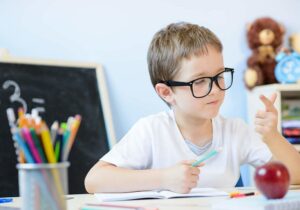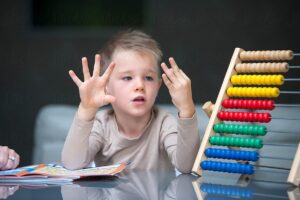In our age of IT-technology the work of the brain is gradually receding into the background. We can’t let go of our phones and tablets, finding the information we need in them. A man no longer strains his brain, hoping that the gadget will give him the answer. That is why it is very important to teach a child to think for himself and to teach a child to count. It is necessary to explain to him that computers are our assistant, but that’s all. That the main activity in life he will have to do by himself, to think for himself. It is necessary to explain to him how do you read an abacus.
In this, a child will be helped by a quick oral counting. It activates the human mind. When solving arithmetic examples, you develop fast reactions, attention, the ability to perceive what is said by ear. Oral math is a great trainer for the brain. Solving even the most elementary examples increases his ability to work. The main thing is to perform the actions very quickly.
THE BEST AGE FOR LEARNING TO COUNT
The best age for starting to learn mental arithmetic is up to 6-7 years old, when the child’s brain is the most plastic and active. Even before you go to school you need to start learning oral counting.
Even in infancy, children become interested in the world around them. Oral counting is one of these entertaining components. Therefore, Mom and Dad should support this interest.
BASIC RULES FOR TEACHING COUNTING
To teach a child to count in the mind, three components are important. Not counting what is the order of pemdas.
Abilities. In order to count quickly, a kid needs to be able to concentrate on what is important, be extremely attentive and remember several things at once.
Knowledge of several techniques of fast mental counting and the ability to choose the most effective in any situation.
Regular practice. So that the skill doesn’t go anywhere, you need to practice all the time. Eventually, the child will start to solve complex problems automatically, which will improve the speed and quality of counting.
METHODS OF TEACHING A CHILD TO COUNT IN THE MIND
The most famous is the fingers of the hand. Counting is done with the fingers. This method develops visual memory and fine motor skills.
Toys or special sets for counting. They are convenient for arithmetic examples. It is better to buy bright objects, without small parts and environmentally friendly.
Developmental educational books with methods and recommendations.
TEACH A CHILD TO COUNT TO 10.
Teach a child to count to 10 is not very difficult. You can start learning as early as 2-3 years. To begin to teach counting to 5, and then continue up to 10. At this age, children know that they have two arms and two legs, one nose and one head. So it will be easier for him to learn. At 3-4 years old child should be taught the concept of “more”, “less”, “equal. This, too, will help to learn the oral count more easily.
TEACHING A CHILD TO COUNT TO 20
After learning to count to 10, you can begin to count to 20. You can practice this at any time. For example, when you go with your baby to kindergarten, you can count cars. Or at lunch count the vermicelli in the soup. Also teach your child to count backwards.
Teaching a child to count to 20 is easier than to 10. Just tell him to add “-teen” to the old numbers. You need to practice every day. Take some time to exercise, 15-20 minutes a day. But regularly. And then the result will not be long in coming.
HOW TO TEACH A CHILD TO COUNT IN 1ST GRADE
Going to school is an important event in the life of any person. During this period the basis for learning new things is formed. At this time, the role of the baby changes. He becomes a student, he has new responsibilities, the level of responsibility increases. He learns not only to learn new subjects, but also to plan his time and distribute the workload in order to have time for everything.
Teaching a child to count in 1st grade is all the more necessary if he didn’t know how to do it before. There are two good methods of teaching mental arithmetic which present information in a playful way:
Zaitsev’s Cubes Method. Children learn by using cubes. Using special tables, first graders learn addition and subtraction. A set of Zaitsev’s cubes includes a manual with recommendations and a CD with songs, which makes the learning process more entertaining.
Glenn Doman’s method. First graders learn to count by means of special cards on which points are depicted. This method forms visual memory.
Of course, both parents and teachers can use other ways of teaching counting. The main thing is that they fit the children and are regularly used. For the result to be impressive, it is necessary to use only one method, so as not to confuse the child.
HOW TO TEACH YOUR CHILD TO COUNT IN 2ND GRADE
The transition to 2nd grade is just as important for a child. Teaching your child to count in 2nd grade is the parents’ and teachers’ job. Not only does your child need to know how to add and subtract, but he or she needs to understand why this is the case.
In arithmetic, consistency and constant memory training are important. Only then will a second grader be able to solve examples with ease. If a student isn’t making much progress in math, you should work with him at home.
To teach a child to count quickly in mind, you can use the following games:
“Shop.” Imagine that you are a buyer, and your child is a seller. Put items on the table: it will be a showcase. Think of a price for each item. And then choose what you will “buy”. And the child should add up all the prices and give you the result.
“Fun Counting.” Stand across from each other. Throw your son or daughter a ball while saying an example. The child must count quickly and give you back the ball with the answer.
“Chains. The child is offered a chain of examples. He has to count the final answer without writing down the intermediate ones.
Also a great technique to improve counting speed is mental arithmetic. This is a program for developing the two hemispheres of the brain at the same time with the help of the ancient abacus. The baby first solves examples on the counting board, going over the bones. And then imagines the abacus in the mind. In this way the whole brain is fully developed. After training in mental arithmetic the child’s speed of perception and information processing increases, he/she can solve multi-digit examples in mind, quickly learn foreign languages, concentrate on important things and correctly arrange his/her time.
TIPS FOR PARENTS
Patience and perseverance are important in any activity. You should not think that you will get results from the first day. To achieve success, you need read https://argoprep.com/blog/gre/participles-in-english-definitions-and-examples/ and to follow a few simple rules:
During classes, look closely at the child’s behavior and understand whether he is interested or bored. If it is the second option, change the method of training.
Do not force your child to study. It is better to explain to the child why it is important to learn to count, and then he/she will want to study.
During the lessons do not shout at your son or daughter, do not snap and certainly do not raise your hand.
Repeat what you have learned every day.
Praise the child for every achievement.
Reinforce the information you receive in daily life. For example, count pigeons in the park or the number of cutlery you have for dinner.
Give your child tasks that are appropriate for his level.
Remember that mental arithmetic develops clarity of thought, reaction time, clarity of mind, and intelligence. It gives a child confidence in his abilities and helps him master the whole school curriculum. Not only in math and physics, but also in the humanities and the sciences.